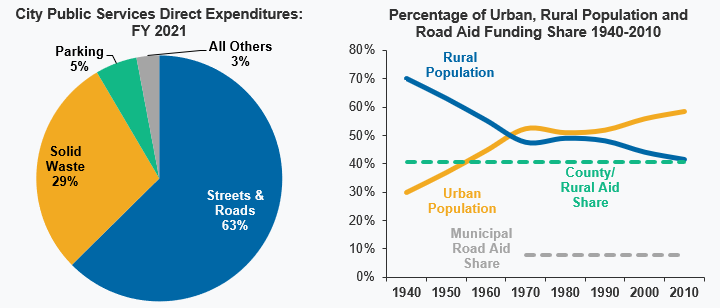Information Central
Streets and Roads
Kentucky cities spend around $325 million a year on constructing and maintaining around 10,000 miles of city streets. Less than one-quarter of that money comes from state or federal sources, such as the state municipal road aid program or federal grants.
Streets and roads is the largest section within the public services spending category. Cities spend streets and roads money on construction and reconstruction (such as filling potholes) as well as on snow removal and treatment, street cleaning, line painting, sidewalks, street lights, etc.
The General Assembly created the municipal road aid program in 1972. It receives 7.7% of the motor fuels tax revenues and distributes funds to incorporated cities based solely on population. The statute also allows “urban areas” to receive funds, which are given to county fiscal courts because the areas are not incorporated cities. One in five county governments receives an average of about $150,000 a year through the municipal road aid program because of this provision.
Rural roadways receive a total of 40.5% of the funds through the county road aid program and the rural secondary program (18.3% and 22.2%, respectively). Both the county road aid and the rural secondary programs distribute their funds using a “formula of fifths” that benefits rural counties. This calculation divides one-fifth of the funds each for (1) equal shares to counties, (2) percent of the state’s rural road mileage and (3) percent of the state’s rural population. The remaining two-fifths are distributed by the county’s proportion of the state’s rural land area. This formula, which was enacted in 1948 and has not since changed, actually hurts counties that are growing rapidly.

Resources
- KLC Research Report: Today's Kentucky City - A Comprehensive Analysis of City Operations (link)
- Kentucky Transportation Cabinet Municipal Road Aid Program (link)
- Kentucky Transportation Cabinet Office of Local Programs (link)
- Kentucky Transportation Cabinet Highway Districts (link)
- Kentucky Transportation Cabinet maps (link)
- Kentuckians for Better Transportation (link)
- KRS 177.366 (PDF)

